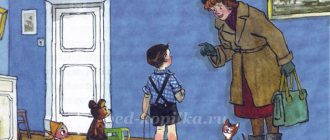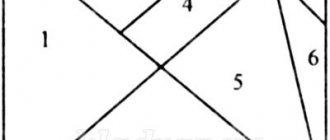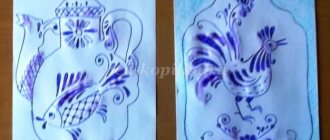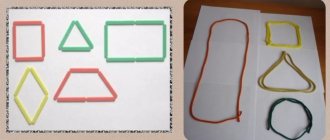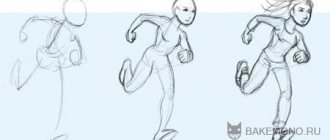Summary of educational activities for speech development in the middle group “Working in the garden”
Tatyana Ratieva
Summary of educational activities for speech development in the middle group “Working in the garden”
Summary of educational activities for speech development in the middle group » We work in the garden and vegetable garden. "
- continue to teach children to compose a story based on a plot picture, develop monologue speech, be able to listen, analyze, negotiate among themselves (who starts the story, who continues, who finishes)
- activate singular and plural present and past tense verbs in children’s speech; learn to correctly use plural genitive nouns; learn to form adjectives from nouns; learn to rhythmically combine movements and speech.
Looking at the paintings “In the garden”; " In the garden"
— What do these paintings have in common? How are they different? Who works in the garden and garden? What time of year do you think it is? Why did you decide so? What are the characters doing in these pictures? How can you say it differently? What are the children doing? (dig, loosen, carry, water, plant, collect (old leaves)
, dig up (weeds.)
- And if you imagine that children have been doing all this for a long time? How do you answer the question: “What did the children do?”
(They dug, loosened, mowed, watered, planted, collected, dug up.)
- Now imagine that you are working in the garden. Ksenya. What are you doing? (I dig, I plant.)
Petya, what are you doing? (I collect and water.)
Tasks:
Formation of a positive attitude towards nature in children.
To form knowledge and develop children’s skills in caring for natural objects.
To instill in children the motive for socially significant work.
Improve children's labor skills and abilities.
Materials for the lesson: oilcloth, aprons, disposable cups for each child, a stick, a watering can with water, a box or bucket of soil, scoops, jars with cuttings in water for each child, the teacher has several indoor plants (Geranium), from which cuttings are taken .
Progress of the lesson
Introductory conversation with children about indoor plants. • What plants do you know in this corner of nature? (Children name several plants.) • Why are they called indoor plants? (These are plants that in our area do not grow in the open ground all year round, because they do not tolerate cold winters.) Surprise moment: A knock is heard on the door, the postman comes in and brings a beautiful box. The teacher explains that in order to find out what is in the box and open it, you need to guess the riddle: Riddle. Round leaves, Lush flowers, Even very good - That’s what the kids decided. On the window so early... (geranium) blossomed.
Educator: Each flower is beautiful in its own way. Geranium is a symbol of warmth and comfort, a symbol of a home where you are always welcome. It’s not for nothing that geranium is called “grandmother’s flower.” “Granny” means dear, familiar, homely... The flower was born far, far away in South Africa. Travelers and seafarers brought it to us. Everyone liked it because it blooms so beautifully. Let's take a closer look at geranium (pelargonium). This plant is light-loving, it has a straight stem, rounded, light green leaves on long cuttings. Brown, brownish circles seem to be drawn on the leaves. Flowers grow in a “bouquet” - an inflorescence.
Planting a cutting. Educator: Guys, who wants to plant a geranium cutting and then give such a beautiful plant to their mother? (Children speak out.) How to plant cuttings? (Teacher demonstration.)
Make a hole with a stick, stick it into the ground and scroll.
Place the cutting in a hole in the ground.
Press the soil near the cuttings, but not too close to the stem.
Water the planted cuttings.
Independent work activity. Planting cuttings by children. Children count the number of leaves and remember. When a new leaf appears, the cutting has taken root and is growing. Water the plant.
Outcome of the lesson: Talk with children about caring for plants. Remind them that the children will bring these plants as a gift to their mother.
MAGAZINE Preschooler.RF
Abstract "Collective work in nature"
Goal: to create conditions for the formation of cognitive interests and cognitive actions of the child through his inclusion of collective work in nature.
Tasks:
Educational:
- Teach children how to plant different types of plants,
- Introduce the characteristics of plant growth and development and how to care for them.
- To develop in children the ability to work in a large team, to teach them to evaluate common work, their share of participation in it, and the work of a friend from the standpoint of achieving a common result.
- Improve labor skills in caring for plants, the ability to independently use equipment, and work at a uniform pace.
Educational:
- Develop gross and fine motor skills.
- Develop curiosity, intelligence, and cognitive abilities.
- Develop a positive attitude towards physical work.
Educational:
- To cultivate hard work, a sense of mutual assistance, friendliness, and accuracy.
- To develop strong-willed qualities, patience, endurance, the desire to achieve a common goal, and conviction in the social significance of work.
- To cultivate a love for nature, respect for it, and care for living things.
Material:
Seeds of various plants, soil, scoops for pouring soil, cups for planting seeds, watering cans with water, sticks for loosening the soil, oilcloths, aprons, toys (any).
Progress:
Educator - Guys, this morning, our friend, the dog Sharik, turned to me and asked me to help plant seeds.
Sharik - Hello guys, I decided to plant different flowers, can you help me, otherwise I can’t do it alone?
Children - Yes!
Educator: Tell me guys, what time of year is it now? (winter) Where can we plant plant seeds? (in a group) Why can’t they be planted outside? (they will freeze in winter) And then, when the sprouts appear, can we plant the seedlings on the plot?
Children - Yes, but we just need to wait until spring, so it’s warm, then we can plant our seedlings in the ground on the site.
Sharik - Oh, guys, I forgot how to plant seeds correctly.
Children are reminded of the sequence of planting seeds - first we pour soil into a glass, then with a stick we make a hole, shallowly (there is a division on the stick), then we put one seed and carefully sprinkle it with earth using a small spoon, then we carefully water it with water and put it on the window.
Sharik - Why do you need to put it on the window?
Children - So that the sun warms the seeds and they sprout faster.
Sharik - Well, let's quickly plant the seeds.
The children start working. When the seeds are planted, an analysis of the work done is carried out. Children evaluate their own work.
Sharik - Oh, thank you very much guys, I’m glad that there are such good helpers, in the spring we will meet again to plant our seedlings on the plot. Goodbye.
Children clean up their workspaces and sit down to draw pictures “How I planted a seed.”
Then everyone together creates an observation book “How a seed grows”
| Next > |
